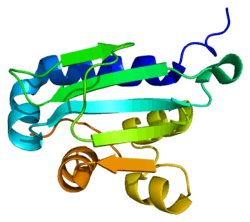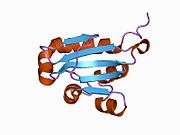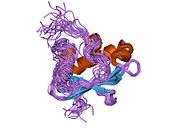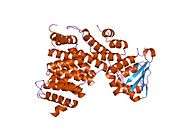SCP2
Non-specific lipid-transfer protein also known as sterol carrier protein 2 (SCP-2) or propanoyl-CoA C-acyltransferase is a protein that in humans is encoded by the SCP2 gene.[5][6]
Function
This gene encodes two proteins: sterol carrier protein X (SCPx) and sterol carrier protein 2 (SCP2), as a result of transcription initiation from 2 independently regulated promoters. The transcript initiated from the proximal promoter encodes the longer SCPx protein, and the transcript initiated from the distal promoter encodes the shorter SCP2 protein, with the 2 proteins sharing a common C-terminus. Evidence suggests that the SCPx protein is a peroxisome-associated thiolase that is involved in the oxidation of branched chain fatty acids, while the SCP2 protein is thought to be an intracellular lipid transfer protein. Alternative splicing of this gene produces multiple transcript variants, some encoding different isoforms. The full-length nature of all transcript variants has not been determined.[7]
Clinical significance
This gene is highly expressed in organs involved in lipid metabolism, and may play a role in Zellweger syndrome, in which cells are deficient in peroxisomes and have impaired bile acid synthesis.[7]
Interactions
SCP2 has been shown to interact with Caveolin 1[8] and peroxisomal receptor PEX5.[9]
References
- GRCh38: Ensembl release 89: ENSG00000116171 - Ensembl, May 2017
- GRCm38: Ensembl release 89: ENSMUSG00000028603 - Ensembl, May 2017
- "Human PubMed Reference:". National Center for Biotechnology Information, U.S. National Library of Medicine.
- "Mouse PubMed Reference:". National Center for Biotechnology Information, U.S. National Library of Medicine.
- Yamamoto R, Kallen CB, Babalola GO, Rennert H, Billheimer JT, Strauss JF (January 1991). "Cloning and expression of a cDNA encoding human sterol carrier protein 2". Proc. Natl. Acad. Sci. U.S.A. 88 (2): 463–7. doi:10.1073/pnas.88.2.463. PMC 50831. PMID 1703300.
- He Z, Yamamoto R, Furth EE, Schantz LJ, Naylor SL, George H, Billheimer JT, Strauss JF (October 1991). "cDNAs encoding members of a family of proteins related to human sterol carrier protein 2 and assignment of the gene to human chromosome 1 p21----pter". DNA Cell Biol. 10 (8): 559–69. doi:10.1089/dna.1991.10.559. PMID 1718316.
- "Entrez Gene: SCP2 sterol carrier protein 2".
- Zhou M, Parr RD, Petrescu AD, Payne HR, Atshaves BP, Kier AB, Ball JM, Schroeder F (June 2004). "Sterol carrier protein-2 directly interacts with caveolin-1 in vitro and in vivo". Biochemistry. 43 (23): 7288–306. doi:10.1021/bi035914n. PMID 15182174.
- Stanley WA, Filipp FV, Kursula P, Schüller N, Erdmann R, Schliebs W, Sattler M, Wilmanns M (December 2006). "Recognition of a functional peroxisome type 1 target by the dynamic import receptor pex5p". Mol. Cell. 24 (5): 653–63. doi:10.1016/j.molcel.2006.10.024. PMC 5030714. PMID 17157249.
Further reading
- Seedorf U, Ellinghaus P, Roch Nofer J (2000). "Sterol carrier protein-2". Biochim. Biophys. Acta. 1486 (1): 45–54. doi:10.1016/s1388-1981(00)00047-0. PMID 10856712.
- Gallegos AM, Atshaves BP, Storey SM, et al. (2001). "Gene structure, intracellular localization, and functional roles of sterol carrier protein-2". Prog. Lipid Res. 40 (6): 498–563. doi:10.1016/S0163-7827(01)00015-7. PMID 11591437.
- Yamamoto R (1993). "[Localization of human sterol carrier protein 2 gene and cDNA expression in COS-7 cell]". Hokkaido Igaku Zasshi. 67 (6): 839–48. PMID 1483685.
- Baker ME, Billheimer JT, Strauss JF (1992). "Similarity between the amino-terminal portion of mammalian 58-kD sterol carrier protein (SCPx) and Escherichia coli acetyl-CoA acyltransferase: evidence for a gene fusion in SCPx". DNA Cell Biol. 10 (9): 695–8. doi:10.1089/dna.1991.10.695. PMID 1755959.
- Schroeder F, Butko P, Nemecz G, Scallen TJ (1990). "Interaction of fluorescent delta 5,7,9(11),22-ergostatetraen-3 beta-ol with sterol carrier protein-2". J. Biol. Chem. 265 (1): 151–7. PMID 2294101.
- Ohba T, Holt JA, Billheimer JT, Strauss JF (1995). "Human sterol carrier protein x/sterol carrier protein 2 gene has two promoters". Biochemistry. 34 (33): 10660–8. doi:10.1021/bi00033a042. PMID 7654720.
- Ohba T, Rennert H, Pfeifer SM, et al. (1995). "The structure of the human sterol carrier protein X/sterol carrier protein 2 gene (SCP2)". Genomics. 24 (2): 370–4. doi:10.1006/geno.1994.1630. PMID 7698762.
- Woodford JK, Colles SM, Myers-Payne S, et al. (1995). "Sterol carrier protein-2 stimulates intermembrane sterol transfer by direct membrane interaction". Chem. Phys. Lipids. 76 (1): 73–84. doi:10.1016/0009-3084(95)02436-M. PMID 7788802.
- Vesa J, Hellsten E, Barnoski BL, et al. (1994). "Assignment of sterol carrier protein X/sterol carrier protein 2 to 1p32 and its exclusion as the causative gene for infantile neuronal ceroid lipofuscinosis". Hum. Mol. Genet. 3 (2): 341–6. doi:10.1093/hmg/3.2.341. PMID 8004106.
- Seedorf U, Brysch P, Engel T, et al. (1994). "Sterol carrier protein X is peroxisomal 3-oxoacyl coenzyme A thiolase with intrinsic sterol carrier and lipid transfer activity". J. Biol. Chem. 269 (33): 21277–83. PMID 8063752.
- Szyperski T, Scheek S, Johansson J, et al. (1993). "NMR determination of the secondary structure and the three-dimensional polypeptide backbone fold of the human sterol carrier protein 2". FEBS Lett. 335 (1): 18–26. doi:10.1016/0014-5793(93)80431-S. PMID 8243660.
- Seedorf U, Scheek S, Engel T, et al. (1994). "Structure-activity studies of human sterol carrier protein 2". J. Biol. Chem. 269 (4): 2613–8. PMID 8300590.
- Yanase T, Hara T, Sakai Y, et al. (1996). "Expression of sterol carrier protein 2 (SCP2) in human adrenocortical tissue". Eur. J. Endocrinol. 134 (4): 501–7. doi:10.1530/eje.0.1340501. PMID 8640304.
- Stolowich NJ, Frolov A, Atshaves B, et al. (1997). "The sterol carrier protein-2 fatty acid binding site: an NMR, circular dichroic, and fluorescence spectroscopic determination". Biochemistry. 36 (7): 1719–29. doi:10.1021/bi962317a. PMID 9048555.
- Schalk JA, Offenberg HH, Peters E, et al. (1999). "Isolation and characterization of the human SCP2 cDNA and chromosomal localization of the gene". Mamm. Genome. 10 (6): 642–4. doi:10.1007/s003359901062. PMID 10341103.
- Jatzke C, Hinz HJ, Seedorf U, Assmann G (1999). "Stability and binding properties of wild-type and c17s mutated human sterol carrier protein 2". Biochim. Biophys. Acta. 1432 (2): 265–74. doi:10.1016/S0167-4838(99)00114-4. PMID 10407148.
- Kimura H, Fujii H, Suzuki S, et al. (1999). "Lipid-binding proteins in rat and human kidney". Kidney Int. Suppl. 71: S159–62. doi:10.1046/j.1523-1755.1999.07141.x. PMID 10412765.
- Huang H, Ball JM, Billheimer JT, Schroeder F (1999). "The sterol carrier protein-2 amino terminus: a membrane interaction domain". Biochemistry. 38 (40): 13231–43. doi:10.1021/bi990870x. PMID 10529196.







